|
August 15, 2011 01:14:22
Posted By DelvecchioRC
|
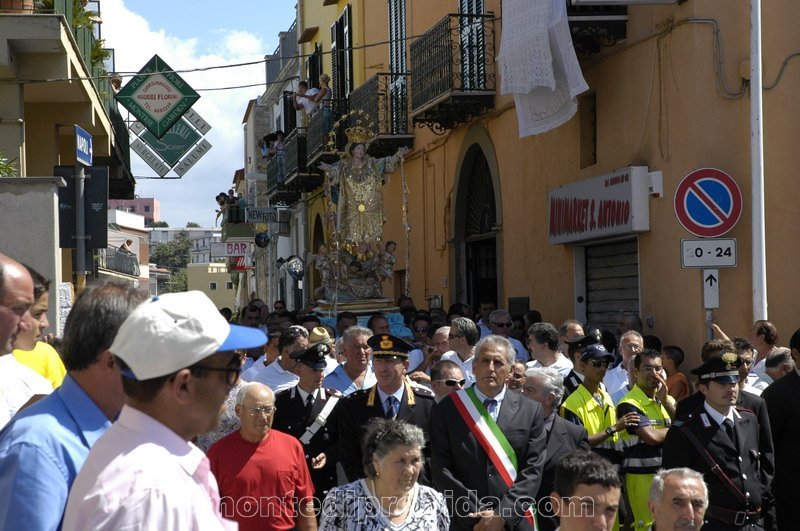
The statue of Our Lady of the Assumption at Sacred Hearts-St. Stephen Church in Brooklyn was brought to America by the people of Monte di Procida, Italy. The Story of their devotion is as follows:
The Assunta celebration is one of the most profound but less known traditions in the phlegreian land. But how is it born the devotion for the Madonna Assunta (the Virgin of Assumption)? What the roots of a tradition which mixes, as so often happens, sacred and profane, popular beliefs and religious precepts?A fascinating story, which mirrors the history itself of the birth and the growth of the city from the first nomad groups of peasants coming from the isle of Procida, who came to establish on the cliffs straight down to the sea of the Monte, in seventeenth century, to the present days. And in more than four centuries of history, the Assunta never stopped being worshipped. When the first colonists coming from Procida started to settle down in the lands owned by cardinal Filomarino, to work in the fields, vineyards and vegetables were verdant through the whole headland and the Virgin’s patronage was yet invoked as to she granted a huge harvest. Then the inhabitants of Monte bounded for the sea routes, and to the Virgin they made vows at every crossing, as she watched over the sea and the destiny of those who sailed challenging the waves for fishing or commerce. The navy of Monte di Procida became, soon, one of the best in the “land of fire” and the devotion even deeper than before. To participate to the celebration, over all for those who were far away, represented a most important event: to miss it was considered more serious than not being home at Christmas or Easter...Phrases that sailors kept repeating to one another: in every point of the world they were, from the ship’s boy to the captain, they followed by heart the procession, to which they could not be present in person; with eyes bright of emotion they could hardly hide, they accompanied the various moments of the ceremony with the sound of the siren. To sum up, even in the back of beyond, they followed the Virgin, they too were “Appriess’ a Maronna” united in spirit to whom, remained in the city to wait for them, was following the statue, eventually praying for them. And when so many people were obliged to emigrate “a’ Maronn” followed them. And they rewarded Her with a devotion profound and full of nostalgia for the native land so far, of which the Assunta represented an unforgettable “piece”, to the point that they organized a “Festa d’a Madonna” even in the States, with the same statue, a perfect copy of the Assunta by Verzella kept in the parish church in the central square, if it was completely impossible to come home for the 15th of August to follow the procession, to be grateful for the fortunes granted and repay the vows fulfilled.
|
|
June 27, 2011 08:14:50
Posted By DelvecchioRC
|
1930's (Carroll & VanBrunt St.s - looking up to Hicks Street) St. Stephen's Roof can be seen in the upper left side of the photo.
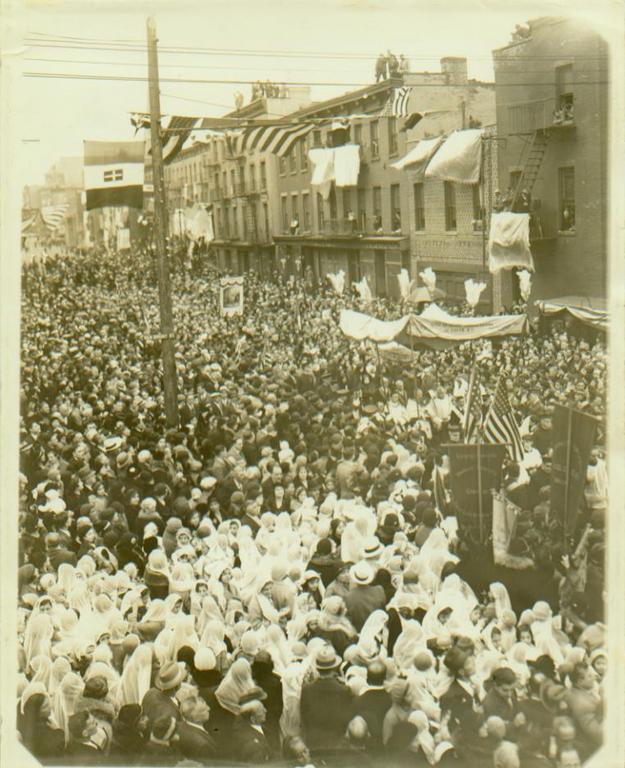
1950's (Msgr. Delvecchio on the steps of the church - after reconsturction of Church building)
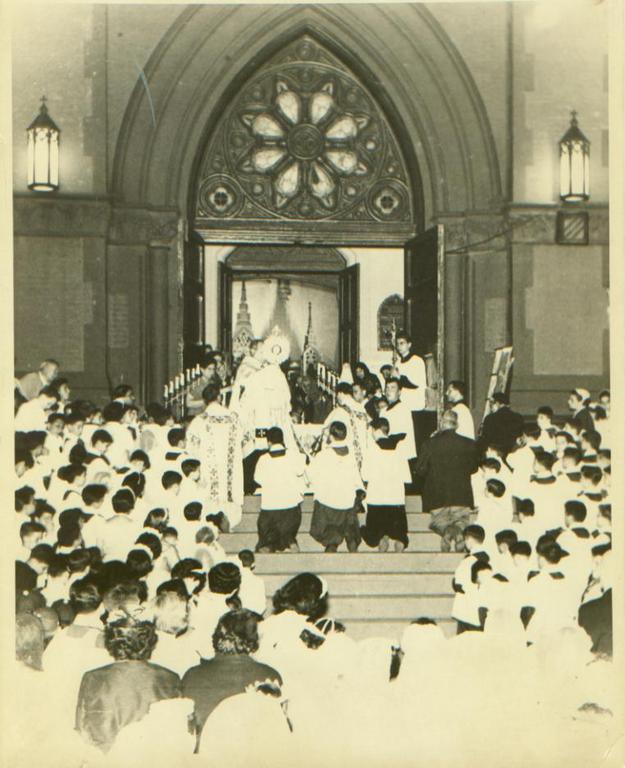
2002
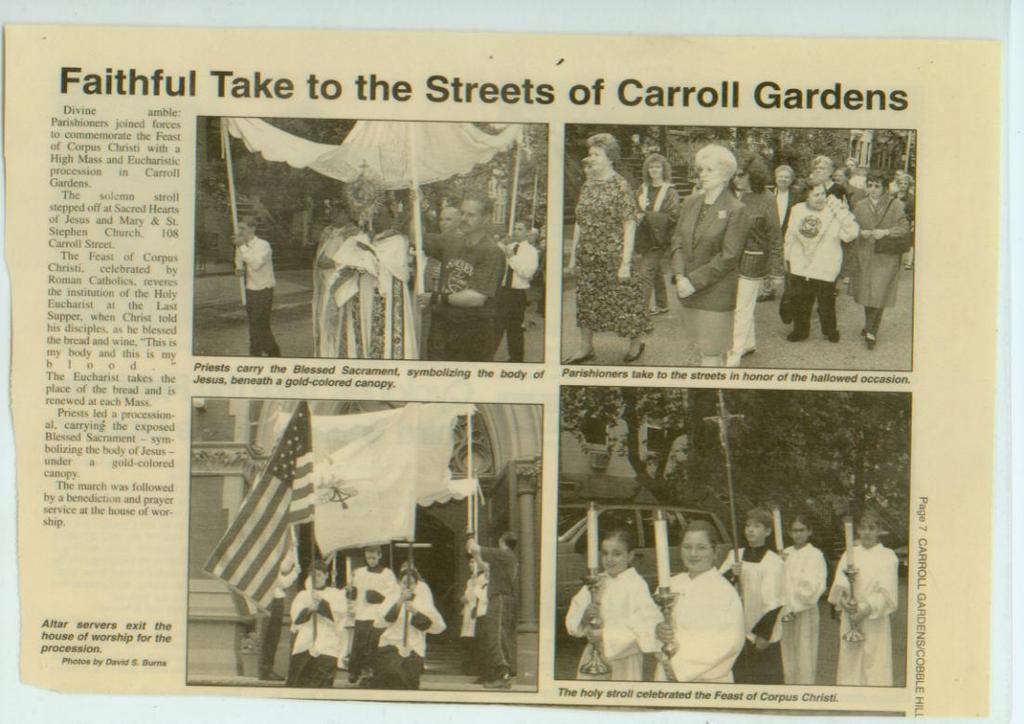
|
|
June 24, 2011 08:32:08
Posted By DelvecchioRC
|
Photo of Corpus Christi Procession from Sacred Hearts of Jesus and Mary PArish in the 1930's on Vanbrunt and Union Streets
The celebration of Corpus Christi became widespread only after both St. Juliana and Bishop Robert de Thorete had died. In 1263 Pope Urban IV investigated claims of a Eucharistic miracle at Bolsena, in which a consecrated host began to bleed. In 1264 he issued the papal bull Transiturus de hoc mundo in which Corpus Christi was made a feast throughout the entire Latin Rite. This was the very first papally sanctioned universal feast in the history of the Latin Rite.
A new liturgy for the feast was composed by St. Thomas Aquinas. This liturgy has come to be used not only on the Feast of Corpus Christi itself but also throughout the liturgical year at events related to the Blessed Sacrament. The hymn Aquinas composed for Vespers of Corpus Christi, Pange Lingua, is also used on Holy (Maundy) Thursday during the procession of the Blessed Sacrament to the altar of repose. The last two verses of Pange Lingua are also used as a separate hymn, Tantum Ergo, which is sung at Benediction of the Blessed Sacrament. O Salutaris Hostia, another hymn sung at Benediction of the Blessed Sacrament, comprises the last two verses of Verbum Supernum Prodiens, Aquinas' hymn for Lauds of Corpus Christi. Aquinas also composed the propers for the Mass of Corpus Christi, including the sequence Lauda Sion Salvatorem. The epistle reading for the Mass was taken from Paul's First Epistle to the Corinthians (1 Corinthians 11:23-29), and the Gospel reading was taken from the Gospel of John (John 6:56-59).
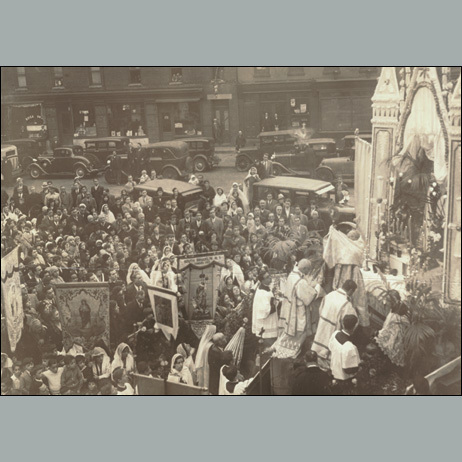
Corpus Christi
|
Categories:
Events,
History
|
May 20, 2011 10:29:24
Posted By DelvecchioRC
|
|
|
|
May 18, 2011 11:38:06
Posted By DelvecchioRC
|
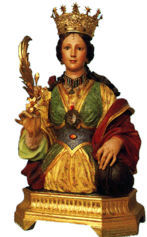
Brought to Sacred Hearts-St. Stephen Church by the people of Ischia, the image of Santa Restituta can be found on the Sacred Heart side of the church in the center of the second Altar from the entrance of the church.
She was said to be born at Carthage or at Hippo Diarrhytus (today known as Bizerte, Tunisia) and became a martyr under Diocletian. The exact place and time of her martyrdom lacks precise historical data. She is sometimes considered one of the Martyrs of Abitina, a group of North African martyrs that incluyes Dativus, Saturninus, and others.
A later medieval legend, recounted by Pietro Suddiacono in the 10th century and similar to legends associated with Saints Devota, Reparata, and Torpes of Pisa, states that after being horribly tortured, Restituta was placed in a blazing boat loaded with oakum and resin. Restituta was unharmed by the fire, and asked for aid from God. God sent an angel to guide her boat to the island of Aenaria (present-day Ischia), and she landed at the present-day site of San Montano. The legend further states that a local Christian woman named Lucina had dreamt of the angel and the boat. When she walked to the beach, she found the resplendent and incorrupt body of Restituta, who was now dead. Lucina gathered the population together and the saint was solemnly buried at the foot of Monte Vico in Lacco Ameno, where a paleochristian basilica was dedicated to her, and is now the site of a sanctuary dedicated to her.
However, the spread of her cult from North Africa to Italy is historically associated with the expulsion of Catholics from North Africa by Genseric, king of the Vandals, who followed the Arian sect. Her relics may have been brought to Naples in the fifth century by Gaudiosus of Naples when he was exiled from North Africa. A church, Santa Restituta, was built in her honour in Naples in the sixth century. The church was then incorporated into the Cathedral of Naples built on the same site in the 13th century. She is the patron saint of Lacco Ameno. She is especially venerated on the island of Ischia and at Lacco Ameno, where she is celebrated in a three-day celebration running from May 16 to May 18.
A crypt associated with Restituta can be found at Cagliari, in the neighborhood of Stampace.
|
Categories:
History,
Saints
|
|
|


